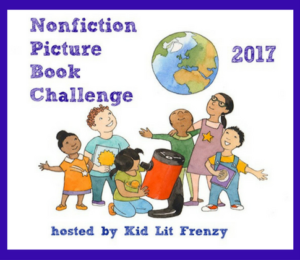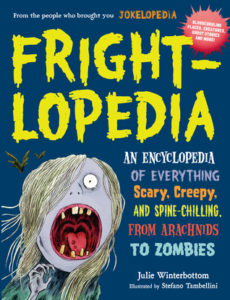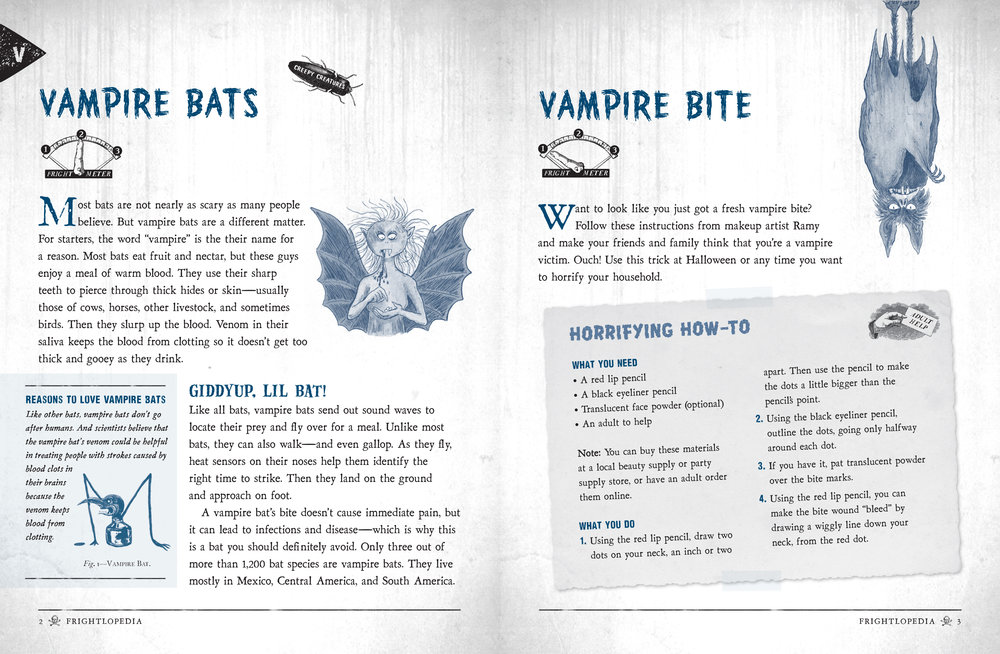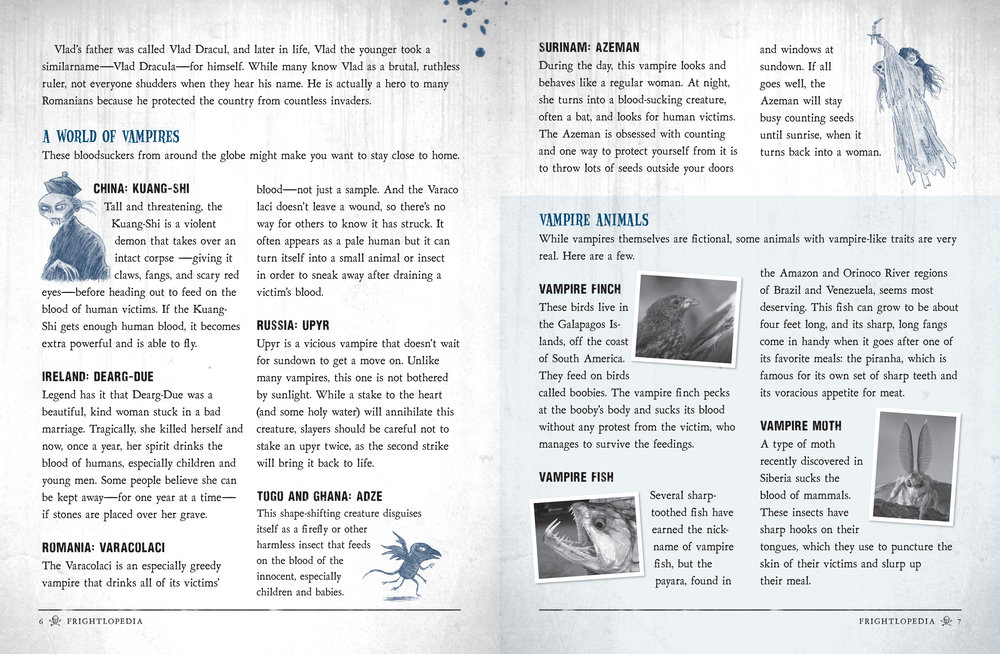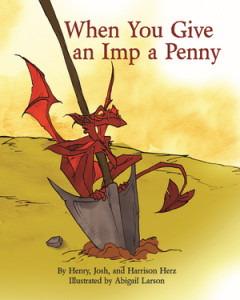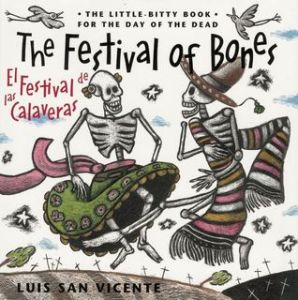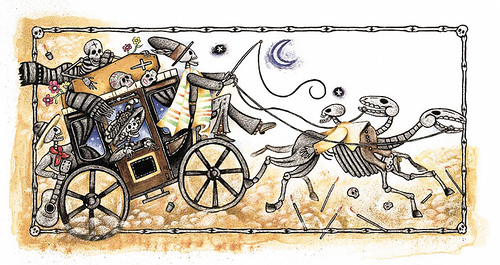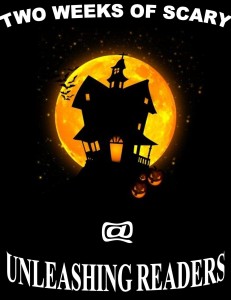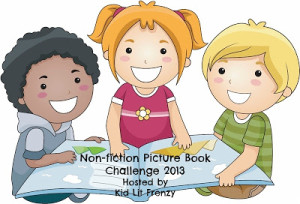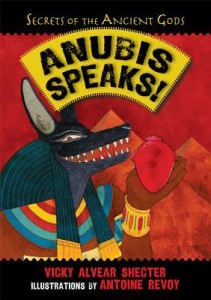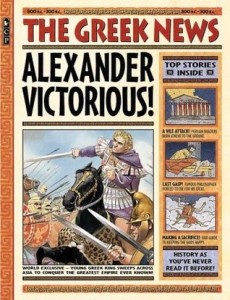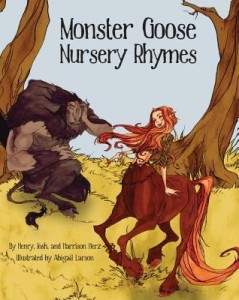
Monster Goose Nursery Rhymes
Authors: Henry, Josh, and Harrison Herz
Illustrator: Abigail Larson
Published February 7th, 2015 by Pelican Publishing Company
Goodreads Summary: Enter an enchanted land of mythical creatures where manticores reign and ogres roar-a land of mystery and fright. A unique twist on traditional rhymes of everyone’s youth, “Monster Goose Nursery Rhymes” presents a more sinister approach to these childhood classics, and yet the sing-song nature of the poems renders them playful and jovial at the same time. Little Witch Muffet is not frightened by a silly, little spider; she simply adds him to her stew!
Rotten zombies, giants, dwarves, and goblins mingle with werewolves, centaurs, and fauns. Follow along the skeleton stepping stones, scale up a palisade, claw at the window of a tasty child and bake him into a pumpkin shell. Monsters cook up delicious elvish pie, too! Every kid who has an eensy weensy bit of sense wants a pet with feathers white as snow, who flies like an eagle and bleats like a goat-a hippogriff, of course!
Six forest sprites with four times as many pixies escape from a loaf of bread atop the elaborate table of the fey queen; her feast has flown away! If you enjoy mischief and have a penchant for the morbidly hilarious, the Herzs’ rhymes will satisfy your mythological curiosities.
Larson’s illustrations give new life to these ancient figures, and her artistic style employs the bold lines and colorful movement of an action-packed comic book. The author also includes a “bestiary” with information about the book’s legendary creatures, which hail from Scotland, Germany, Italy, Persia, Haiti, and Scandinavia.
Kellee’s Review and Teachers’ Tools for Navigation: Really like the creativity of mashing monster/mythology and nursery rhymes. A great intro to all things traditional lit and fantasy in a rhyming, fun way. I especially liked that the creatures hail from a variety of places and that the author included an appendix that includes information about each of them. I think this book would be a great way to introduce mythology as well as give students an opportunity to make their own parody of a nursery rhyme using a creature.
One thing that makes this book special is that Henry Herz wrote this book with his two sons. I am happy to share with you a post about their collaboration:
Josh, Harrison, and Dad’s Excellent Adventure

The astute observer will notice that there are three author credits for Monster Goose Nursery Rhymes. That’s because my young sons were involved in its creation. This is the tale of how two boys became traditionally published authors.
A few years ago (in a galaxy far away), I wanted to share my love of fantasy with my young sons. They were too little for watching most of the fantasy and sci-fi movie classics, and there are only so many good fantasy books available for that age range. Struck by inspiration one day, I came up with a way to share the joy of entering the magical realms of fantasy. I would write a fantasy book for them.
What I did not anticipate was that my boys would give me feedback on the story. They devised some of the character (Nimpentoad) and creature (Neebel) names and made plot line suggestions. And who better to help make the story appealing to kids than other kids? So, the goal of interesting my sons in fantasy transformed into also encouraging them to write.
Originally, I only shared the story of Nimpentoad with family, for their own enjoyment. I had no thoughts of having the book published. But one day, my sister-in-law suggested that I consider publication because she felt the story was much better than many of the books she was seeing for her similarly-aged kids. I thought about it for a while, and decided to give it a try.
The first step was to find the right artist. Once again, my sons were involved, this time in providing art direction. We would explain in words what each illustration should contain. Collaborating remotely via email and DropBox, our artist would give us a rough sketch, and we would provide feedback on details and color palette. Nimpentoad came to life, while my boys added another dimension to their experience.
Given the amount of time that had passed, as well as the anticipated challenges with finding an agent or publisher willing to take a chance on an unproven writer, we decided to indie-publish. The response to Nimpentoad was encouraging, and we subsequently indie-published Twignibble (an easy reader about a mechanically-inclined sloth, who travels the world helping his endangered animal friends), and How the Rhino Got His Skin (an updated picture book version of Rudyard Kipling’s classic).
We’ve done book readings and signings at schools, libraries, museums, farmer’s markets, book fairs, and bookstores. My boys are now experienced sales professionals! They know how to handle themselves with new people, and easily sell more books than I do.
Like any good author, I am committed to honing my craft. I belong to critique groups, participate in Tara Lazar’s annual Picture Book Idea Month (PiBoIdMo) event, and took a picture book writing class at UCSD. Part of the class curriculum was to draft some picture book manuscripts. Kids love monsters and I love monsters (being a big kid myself), and so the idea for Monster Goose Nursery Rhymes was born.
As with our other collaborations, I drafted the book, and then had my sons review it. Then it went through my critique group and more revisions. I subsequently attended the Orange County Editor’s Day event hosted by the Society of Children’s Book Writers and Illustrators (SCBWI). Monster Goose Nursery Rhymes won best picture book. After that, it was time to query agents and editors. Happily, several editors expressed interest. We chose Pelican Publishing, and the rest is history.
Writing rhyming picture books is very challenging (see why at http://wp.me/p31Xf4-K0). I jokingly encourage newbie writers to visit www.DontDoRhyme.com (not a real website). The irony is not lost on me that my debut traditionally published picture book is in rhyme. My only excuse is that I didn’t have to invent the meter, I just had to twist the words to fit the existing meter.
If you want to interest your kids in mythological creatures, or fantasy literature in general, give Monster Goose Nursery Rhymes a look. Just take care – Monster Goose Nursery Rhymes is a gateway book to The Lightning Thief and, eventually, to The Lord of the Rings.
Learn more about Monster Goose Nursery Rhymes at http://www.birchtreepub.com/mgnr.htm.
Recommended For:




**Thank you to Henry L. Herz for providing a copy for review and for the guest post!**
